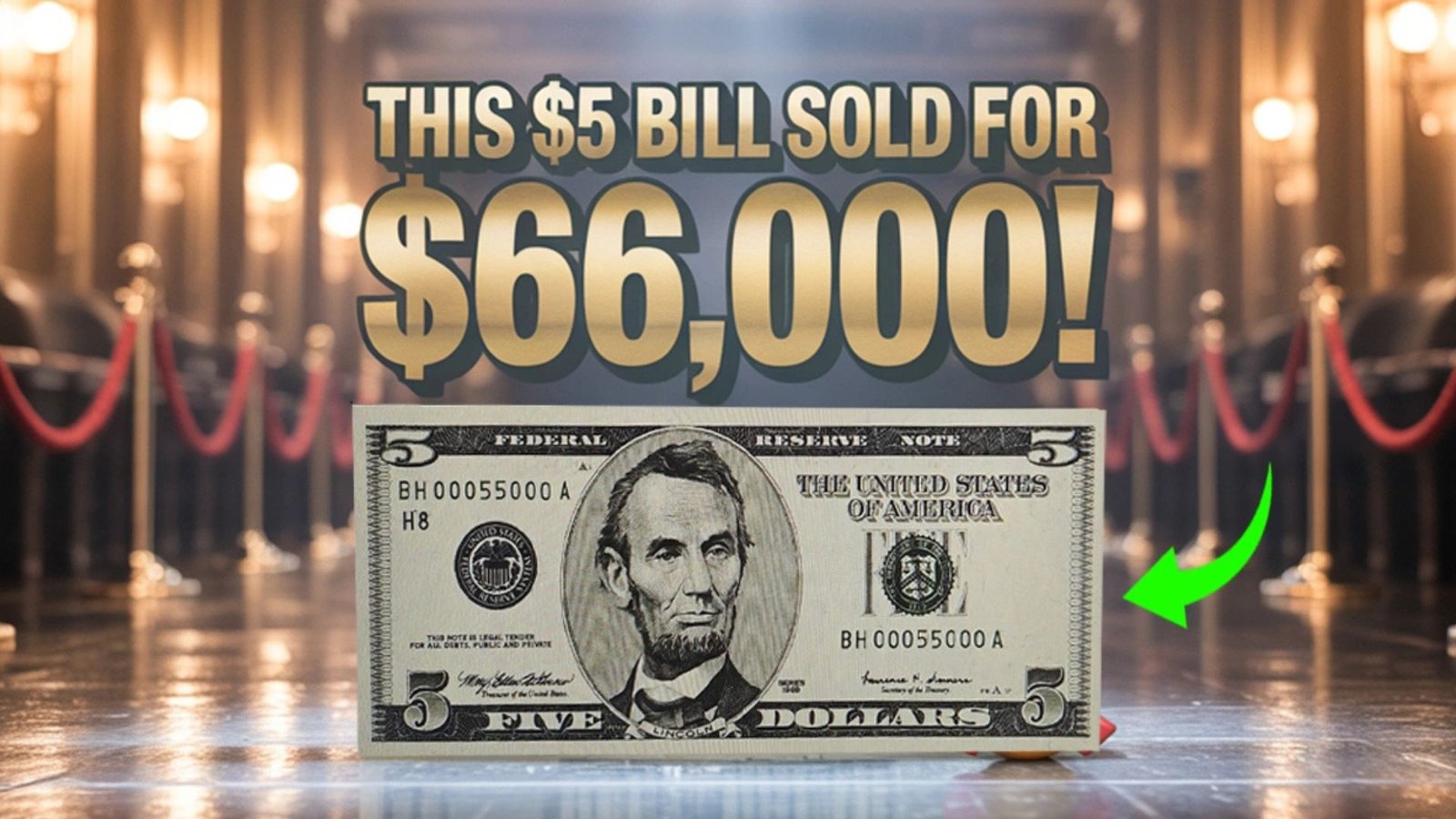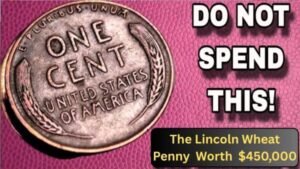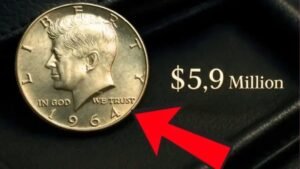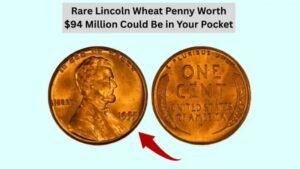Before you spend that $5 bill in your wallet, take a closer look—it could be worth thousands! In 2025, a rare $5 bill with a unique serial number sold for $66,000 at auction, exciting coin and currency collectors. Known as a “solid serial number” or other fancy patterns, these rare bills turn everyday cash into a collector’s dream. This SEO-optimized guide explains how to spot a valuable $5 bill, why certain serial numbers are so special, and how to cash in on a potential treasure hiding in your change.
What Is a Rare Serial Number $5 Bill?
The $5 bill, featuring Abraham Lincoln on the front (obverse) and the Lincoln Memorial on the back (reverse), has been in circulation since 1928. Most are worth just $5, but bills with unique serial numbers—those green or black numbers printed on the front—can be extremely valuable. A serial number is a unique code, like a fingerprint for each bill. Collectors prize patterns like solid digits (e.g., 77777777) or ladder numbers (e.g., 12345678), especially on bills from specific years like 1963, 1969, or 2013.
Why Are Some $5 Bills So Valuable?
The value of a $5 bill depends on its serial number, condition, and rarity. Key factors include:
- Unique Serial Numbers: Patterns like solid digits, ladders, or low numbers (e.g., 00000001).
- Year and Series: Bills from certain years, like 1963 or 2013, with rare patterns are more valuable.
- Condition: Uncirculated bills (like new) fetch higher prices when graded by services like PMG or PCGS.
A 2013 $5 bill with a solid serial number (88888888) recently sold for $66,000 due to its perfect condition and rare pattern.
Types of Valuable Serial Numbers
Here are the serial number patterns to look for on your $5 bill:
Solid Serial Number
A solid serial number has the same digit repeated, like 77777777 or 88888888. These are extremely rare, with fewer than 0.001% of bills having this pattern. A 2013 $5 bill with 88888888 sold for $66,000 in 2025.
Ladder Serial Number
Ladder numbers go in sequence, like 12345678 or 87654321. They’re rare and can be worth $1,000–$10,000, depending on condition and series.
Low Serial Number
Bills with low serial numbers, like 00000001 or 00000002, are prized, especially from older series like 1963. They can fetch $500–$5,000.
Star Note with Unique Pattern
Star notes, marked with a star (*) in the serial number, are replacement bills for printing errors. A star note with a solid or ladder number can be worth $2,000–$20,000.
How to Spot a Valuable $5 Bill
To find a rare $5 bill, check these details:
- Serial Number: Look for patterns like 77777777, 12345678, or low numbers like 00000001. The serial number is printed twice on the front.
- Series Year: Check the year (e.g., 1963, 1969, 2013) near Lincoln’s portrait.
- Star Symbol: A star (*) in the serial number indicates a replacement bill, which may increase value.
- Condition: Uncirculated bills with no folds or wear are worth more. Use a magnifying glass to inspect details.
Visit CoolSerialNumbers.com or PMG to compare your bill’s serial number.
Market Value of Rare $5 Bills
Most $5 bills are worth face value, but those with rare serial numbers can fetch high prices:
| Bill Type | Estimated Value | Key Feature |
|---|---|---|
| Regular $5 Bill | $5 | Common, no special serial number |
| Solid Serial Number (e.g., 88888888) | $10,000–$66,000 | Same digit repeated |
| Ladder Serial Number | $1,000–$10,000 | Sequential digits (e.g., 12345678) |
| Low Serial Number (e.g., 00000001) | $500–$5,000 | Very low serial number |
| Star Note with Rare Pattern | $2,000–$20,000 | Star symbol with unique pattern |
Values depend on condition, series year, and grading by PMG or PCGS.
Why Are Rare Serial Numbers So Valuable?
Serial number errors or patterns are rare because the U.S. Bureau of Engraving and Printing produces billions of bills with unique numbers. Only a tiny fraction have special patterns like solids or ladders, and even fewer survive in uncirculated condition. Collectors, or numismatists, pay top dollar for these anomalies, especially if graded as Gem Uncirculated (65–70) by professional services.
How to Sell a Rare $5 Bill
If you find a valuable bill:
- Check the Serial Number: Confirm it’s a solid, ladder, or low number using a magnifying glass.
- Authenticate: Send it to PMG or PCGS for grading to verify authenticity and condition.
- Sell Smart: Contact auction houses like Heritage Auctions or Stack’s Bowers, or sell on eBay after grading.
Avoid cleaning or folding the bill, as damage reduces its value.
Word Translation Table
| Complex Word | Simple Meaning |
|---|---|
| Obverse | Front side of a bill |
| Reverse | Back side of a bill |
| Serial Number | Unique code printed on a bill |
| Uncirculated | Bill with no wear, like new |
| Numismatist | Person who collects bills or coins |
| Star Note | Replacement bill with a star in the serial number |
FAQs
How do I know if my $5 bill is valuable?
Check the serial number for patterns like 77777777 (solid), 12345678 (ladder), or low numbers like 00000001. Look for a star (*) or series years like 1963 or 2013.
What makes a $5 bill worth $66,000?
A solid serial number, like 88888888, in uncirculated condition, as seen in a 2013 $5 bill that sold for $66,000 in 2025, drives high value due to rarity.
Where can I sell a rare $5 bill?
Use auction houses like Heritage Auctions or Stack’s Bowers, or sell on eBay after grading by PMG or PCGS. Local coin shops can also appraise.
Are all $5 bills with a star valuable?
Not all star notes are valuable, but those with solid or ladder serial numbers can be worth $2,000–$20,000 if graded and rare.
Conclusion
Your $5 bill could be a collector’s gem, especially if it has a rare serial number like 88888888, which sold for $66,000 in 2025. Check for solid digits, ladders, low numbers, or star notes, particularly from 1963 or 2013 series. Authenticating with PMG or PCGS and selling through trusted auction houses could turn your bill into a small fortune. Don’t spend that $5 yet—it might be worth thousands! Visit Heritage Auctions or PMG for grading and auction details.




